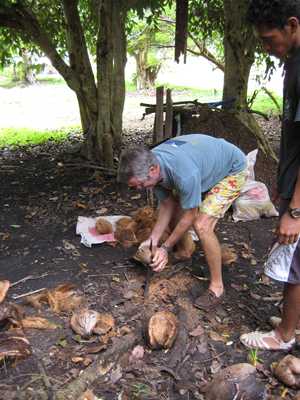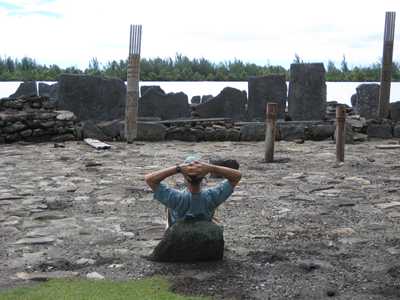Huahine

Peregrina's Journey
Peter and Margie Benziger
Tue 11 Jan 2011 01:22
Position Report
– 16:43.271S 151:01.982W
Huahine, French Society Islands
Leaving Moorea, we made an overnight passage to Huahine and
anchored just off the town of Fare in Haamene Bay on the northwest side of the
island. Huahine is actually two islands
– Huahine Nui (Big Huahine and Huahine Iti (Little Huahine) separated by two
deep bays that essentially bisect the islands.
You can cross from one island to the other over a small road bridge that
spans the gap but, at low tide, you can just as easily wade across. The main road around both islands covers
about 60 miles so we rented a car for a day with Sue and Bill from “Camomile”
and set out to explore the neighborhood.
We decided to tour the island clockwise and headed up and around the
northern end of the island. Throughout
the day, we were presented with incredible views from the “belvedieres” or
lookouts all along the way.
Just a few minutes outside of Fare, we saw a group of men
working in a coconut field and we stopped to investigate. There were several men and a huge pile of
coconuts that they were preparing for copra.
Copra is the dry residue of the white substance lining the inside of the
coconut. Rich in vegetable fat, it is
crushed, heated, pressed and refined into oil and then sold to the food and
cosmetics industry. We watched as these
guys ripped open the coconuts, pounding them onto a large spike and then
tossing the half nuts into a pile that is left in the sun for several
days. Next, the copra producer separates
the dried kernel from the shell and the shavings collected are placed on copra
dryers (racks with roofs to protect them from rain) until they are completely
dessicated and REALLY smelly! Then they
are packed in bags and shipped off to Tahiti where the final product is
processed and sold around the world.
Our next stop was the village of Maeva, where we saw what is
believed to be the most extensive complex of marae in French Polynesia.
Marae are open air rectangular platforms built out of slabs of coral and
blocks of basalt surrounded by a low wall.
They are places of worship as well as the social gathering point for all
village life. Chiefs were installed
here, wars prepared, rituals performed, including human sacrifices. At one end is the ahu, an altar of several
tiers like a stepped pyramid and the most holy place, reserved for the high
priests. Up front, facing the ahu, there
are always three vertical slabs of coral known as “upright stones” with
engraved inscriptions. In the center of
the platform are several “sitting stones” to lean back on. These were intended for the chiefs and
priests symbolizing their rank in the community. At the Maeva Marae Archeological Site,
excavations have been ongoing since 1923 and nearly 30 marae have been located,
more than half restored. It is very
impressive and I LOVE tramping around these historical communities.
We stopped for a picnic lunch at the Sofitel Heiva, one of
Polynesia’s first mega-resorts, now sitting in ruins after a disastrous
hurricane (fyi, they are called typhoons here) in 1998. This hotel first introduced the concept of
the over-the-water bungalows to French Polynesia and subsequently, started a
trend that has spread all over the world.
It was so sad to see the resort in such disrepair.
Moving on, we stopped at Lake Maeva, which is actually an
inlet from the sea. As we crossed the
small bridge crossing the inlet, we saw several v-shaped fish traps made from
coral blocks that were absolutely ingenious.
The tips of the V point towards the ocean so that fish as they are
pulled towards the sea by an ebb tide are trapped in the V as the long stone
arms emerge just at or above sea level.
Once the fish reach the end of the V, there is no turning back and they
are easily caught with a net or harpoon.
These traps have been here for centuries and some are still in use
today.
From here, we continued along the coast road to the village
of Faie, passing pearl farms all along the way.
Peter was driving really fast for some strange reason...He kept noting, “Oh, too bad…that one’s closed. And so is that one. It must be a holiday!” I’m sure you get the picture….
In Faie, we stopped at a bridge along a river to see
Huahine’s famous blue-eyed eels. There
is a small grocery store right next to the bridge and we bought a can of
sardines, which apparently is the food of choice for blue-eyed eels and then
scrambled down to the water’s edge where, within seconds, close to 30 HUMONGOUS
eels slithered out of the rocks along the shoreline and right up to our feet.
(Well, Peter and Bill’s feet, to be precise)
You can tell they are well-fed.
(That grocery store does a booming business in sardines!) And they are
reputedly quite tame but, as you’ll see in the photo, when a four foot eel
extends its body up and out of the water like a cobra and pops its gaping jaw
right at your sardine-filled fingertips, it’s a little disconcerting! But, it was very cool…
We headed on south and stopped at the Relais Mahana, the top
end resort on Huahine Iti just to see how the “other half” (or probably the
other top 2%) were spending their vacation and it was, indeed, lovely with
sweet little beach bungalows along a shady coconut palm beach but, at 35,000
Polynesian francs (roughly $400 per night, room only) it was a bit pricey for
our budget. However, there was a great
reef there for snorkeling/diving and a very nice anchorage where we saw a
number of the BWR boats.
Heading up the coast, we stopped in Haapu on the west coast
of Huahine Iti to see a plantation known for vanilla and noni crops. These two make strange bedfellows whereas the
vanilla plant is so beautifully fragrant and the noni fruit smells just
nauseating, like rancid cheese. However,
they are both real “cash crops” for Polynesia and particularly on Huahine. I didn’t know that vanilla was part of the
orchid family (Did you?) and here on Huahine, it must be hand-fertilized
because the insects that would normally carry on the process are not found in
French Polynesia. We bought a bunch of
vanilla pods from the guy who showed us around the plantation for 1000
francs. We probably got ripped off a bit
but he was nice enough to give us a tour even though the plantation was closed
by the time we arrived. I’ve been
putting the pods in my morning coffee and it really does taste delicious.
Noni has always been known for its medicinal purposes here
in the Society Islands but it has just recently (late 1990’s) begun to enjoy
enormous success in the United States.
Loaded with anti-oxidants and anti-aging properties, Noni juice is the
latest craze in our search for eternal youth.
There is a MASSIVE plant in Tahiti owned by the Morinda Corporation that
purees the noni fruit and then sends it off to the USA to be processed and distributed. It’s a risky business because, as we all
know, these food fads have a very short lifespan and Americans are always in
search of the next magic elixir. (The
Brazilian Acai juice craze comes to mind)
Hopefully, the Polynesians won’t put all their eggs in one basket…
Anyway, from Haapu, we had to step on the gas, cross the
bridge to Huahine Nui and speed up the west coast back to Fare, to drop off the
car by 5pm – all along the way marveling at the beautiful lagoons inside the
reef surrounding the islands. It was a
GREAT day!
In fact, we liked Huahine and the little waterfront village
of Fare so much, we stayed four nights there.
Fare is a very laid back South Seas port town which hasn’t seemed to
change much from its whaling heritage in the 1800’s. We liked the atmosphere along the wharf where
children jumped off the docks and splashed in the water with unabashed joy and
the arrival of ferries and cargo ships was cause for great anticipation and
celebration when friends and family (or a new washing machine) arrived. The main street along the harbor was lined
with small shops, restaurants and little “roulettes” – tricked out cargo vans
or trailers with little kitchenettes - which we affectionately called “roach
coaches” where you could find delicious take-away snacks at reasonable prices. The town is full of young (and old)
backpackers who are drawn here for the great beaches and the spectacular
diving/snorkeling and hiking. One
especially popular bed and breakfast hotel is called Chez Guynette, known more
commonly as “Club Bed.”
Not far from where Peregrina was anchored in the harbor, but
in the shallow waters near the reef, the good people of Fare have positioned a
bare-boned rendition of a large Polynesian catamaran. It sits conveniently over the reef and makes
an ideal take-off point for snorkeling.
The fish and coral here were amazing.
We saw sharks and rays and huge sea cucumbers and sea horses and several
varieties of sea urchins, including a beautiful, but spiky, red Crown of
Thorns. At one point, we watched about
200 long, thin Trumpet Fish pass by and one particular specifies of yellow,
black and white Butterfly Fish, were absolutely convinced that Peter, in his
yellow bathing trunks, was their mother and a sea of them hovered around and
under him wherever he went. It was
hilarious! We dinghied out to the
catamaran several times during our stay and it was definitely one of the best
snorkeling sites we’ve encountered.





